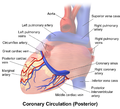Coronary circulation
Coronary circulation refers to the movement of blood through the arteries, veins, and capillaries that supply oxygen-rich blood to the heart muscle (myocardium). This circulatory system is crucial for maintaining the heart's function and overall health. The heart requires a continuous supply of oxygen and nutrients to perform its vital function of pumping blood throughout the body. The coronary circulation system ensures that the heart receives this essential support.
Anatomy of Coronary Circulation[edit]
The coronary circulation system consists of two main coronary arteries that branch off from the aorta just above the aortic valve. These are the left coronary artery (LCA) and the right coronary artery (RCA). Each of these arteries further divides into smaller branches that penetrate the heart muscle, providing oxygenated blood to the myocardium.
Left Coronary Artery (LCA)[edit]
The LCA starts as a single vessel, the left main coronary artery, which then bifurcates into two primary branches:
- The left anterior descending artery (LAD), which supplies blood to the front and bottom of the left ventricle and the front of the septum.
- The circumflex artery (Cx), which supplies blood to the left atrium, side and back of the left ventricle.
Right Coronary Artery (RCA)[edit]
The RCA supplies blood to the right atrium, the right ventricle, the bottom portion of both ventricles, and the back of the septum. It has several branches, including:
- The sinus node artery (SNA), which supplies blood to the sinoatrial node, responsible for the heart's rhythm.
- The right marginal artery and the posterior descending artery (PDA), which supply the right ventricle and the bottom and back of the left ventricle, respectively.
Physiology of Coronary Circulation[edit]
The coronary arteries fill during the heart's relaxation phase, known as diastole. The high pressure in the aorta helps to push blood into the coronary vessels. The oxygen-rich blood travels through the coronary arteries and permeates the heart muscle via a network of capillaries, where oxygen and nutrients are exchanged for carbon dioxide and waste products. The deoxygenated blood is then collected by the coronary veins, which converge into the coronary sinus, and is eventually returned to the right atrium.
Clinical Significance[edit]
Coronary circulation disorders, such as coronary artery disease (CAD), can lead to significant health issues, including heart attack, angina pectoris, and heart failure. CAD occurs when the coronary arteries become narrowed or blocked by plaque buildup, a condition known as atherosclerosis. This can reduce blood flow to the heart muscle, causing chest pain (angina) or a heart attack.
Diagnosis and Treatment[edit]
Diagnosis of coronary circulation issues often involves imaging tests such as coronary angiography, CT coronary angiogram, and stress tests. Treatment may include lifestyle changes, medications, and procedures like angioplasty and coronary artery bypass grafting (CABG) to restore blood flow to the heart muscle.
Conclusion[edit]
Coronary circulation is a vital component of cardiovascular health, ensuring the heart muscle receives the necessary oxygen and nutrients to function effectively. Understanding the anatomy and physiology of coronary circulation helps in the diagnosis and treatment of coronary artery diseases, ultimately contributing to better heart health outcomes.
-
Surface anatomy of the heart
-
Diagram of coronary arteries
-
Diagram of cardiac vessels
-
Gray's anatomy illustration of coronary circulation
-
Coronary arteries
-
Anterior view of coronary vessels
-
Posterior view of coronary vessels
-
Coronary arteries
Ad. Transform your life with W8MD's Budget GLP-1 injections from $75


W8MD offers a medical weight loss program to lose weight in Philadelphia. Our physician-supervised medical weight loss provides:
- Weight loss injections in NYC (generic and brand names):
- Zepbound / Mounjaro, Wegovy / Ozempic, Saxenda
- Most insurances accepted or discounted self-pay rates. We will obtain insurance prior authorizations if needed.
- Generic GLP1 weight loss injections from $75 for the starting dose.
- Also offer prescription weight loss medications including Phentermine, Qsymia, Diethylpropion, Contrave etc.
NYC weight loss doctor appointmentsNYC weight loss doctor appointments
Start your NYC weight loss journey today at our NYC medical weight loss and Philadelphia medical weight loss clinics.
- Call 718-946-5500 to lose weight in NYC or for medical weight loss in Philadelphia 215-676-2334.
- Tags:NYC medical weight loss, Philadelphia lose weight Zepbound NYC, Budget GLP1 weight loss injections, Wegovy Philadelphia, Wegovy NYC, Philadelphia medical weight loss, Brookly weight loss and Wegovy NYC
|
WikiMD's Wellness Encyclopedia |
| Let Food Be Thy Medicine Medicine Thy Food - Hippocrates |
Medical Disclaimer: WikiMD is not a substitute for professional medical advice. The information on WikiMD is provided as an information resource only, may be incorrect, outdated or misleading, and is not to be used or relied on for any diagnostic or treatment purposes. Please consult your health care provider before making any healthcare decisions or for guidance about a specific medical condition. WikiMD expressly disclaims responsibility, and shall have no liability, for any damages, loss, injury, or liability whatsoever suffered as a result of your reliance on the information contained in this site. By visiting this site you agree to the foregoing terms and conditions, which may from time to time be changed or supplemented by WikiMD. If you do not agree to the foregoing terms and conditions, you should not enter or use this site. See full disclaimer.
Credits:Most images are courtesy of Wikimedia commons, and templates, categories Wikipedia, licensed under CC BY SA or similar.
Translate this page: - East Asian
中文,
日本,
한국어,
South Asian
हिन्दी,
தமிழ்,
తెలుగు,
Urdu,
ಕನ್ನಡ,
Southeast Asian
Indonesian,
Vietnamese,
Thai,
မြန်မာဘာသာ,
বাংলা
European
español,
Deutsch,
français,
Greek,
português do Brasil,
polski,
română,
русский,
Nederlands,
norsk,
svenska,
suomi,
Italian
Middle Eastern & African
عربى,
Turkish,
Persian,
Hebrew,
Afrikaans,
isiZulu,
Kiswahili,
Other
Bulgarian,
Hungarian,
Czech,
Swedish,
മലയാളം,
मराठी,
ਪੰਜਾਬੀ,
ગુજરાતી,
Portuguese,
Ukrainian







